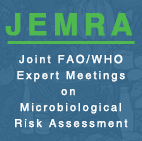 |
Risk Assessment for Cronobacter sakazakii in Powdered Infant Formula |

 |
|
|
|
|
|
|
|
Sampling Plans
The specification and implementation of microbiological criteria is one of the potential control measures that can be employed to reduce the risk of C. sakazakii infection associated with PIF. One of the components of a microbiological criterion is specification of the sampling plan in terms of the number of samples taken from a lot and the mass of individual samples to be examined.
Actions are then specified when the sampling plan indicates that the microbiological criterion is not being met. Such actions may include, for example, preventing the release of the product into domestic or international trade. This tool focuses upon the elimination of lots deemed unacceptable in accordance with the specified sampling plan, and estimates the risk reduction that is obtained as a result of this removal of unacceptable product from the exposure pathway. The tool presented here is designed to explore the impact of two-class sampling plans.
Two-class sampling Plans
A two-class sampling plan is defined in terms of the sample mass, the number of samples to be taken from a given lot, and a threshold concentration. The threshold concentration is a concentration above which a sample is considered to be unacceptable. The number of unacceptable samples that will be tolerated while still accepting the lot is also specified. It is common undertaking sampling to detect, and control, pathogens in food products to select the threshold concentration such that the detection of any pathogens in the samples from the lot will deem that lot unacceptable. This is the approach adopted here for C. sakazakii in PIF; the detection of any positive samples from a lot, regardless of the number of C. sakazakii in that sample, will deem a lot unacceptable and the lot will be rejected.
Using the Sampling Plan Tool
To explore the impact of a sampling plan the following inputs must be specified:
-
Between-lot mean log concentration of C. sakazakii (in log CFU/gram)
-
Standard deviation of the log concentrations between lots (in log CFU/gram)
-
Standard deviation of log concentrations within a lot (in log CFU/gram)
-
Number of samples to be tested from a given lot
-
Mass of each sample to be tested (in grams)
Note that the model assumes that the distribution of concentration between and within a lots follows a lognormal distribution (or a normal distribution of log concentration). This should be considered when determining the mean and standard deviation to be used on risk estimates. The tool presented here enables the exploration of sampling plans in terms of the Risk Reduction obtained through sampling in isolation or in addition to other management options such as preparation and handling methods.
Model Assumptions
- It is assumed in this model that all lots of PIF would be tested against the microbiological criteria. If a lesser degree of testing was undertaken (e.g. only every other lot tested), the ability of the testing program to remove unacceptable lots would decrease proportionally.
- It is assumed that the concentration of C. sakazakii both between and within lots of PIF can be described by a lognormal distribution, or equivalently the log concentration follows a normal distribution.
|
|
|
|
|
|
|
|
|
|